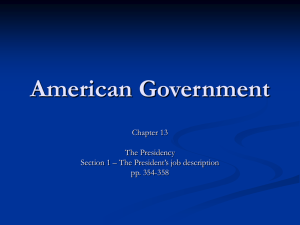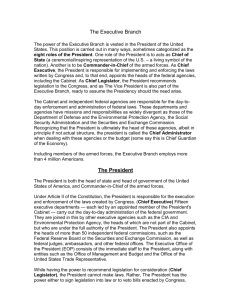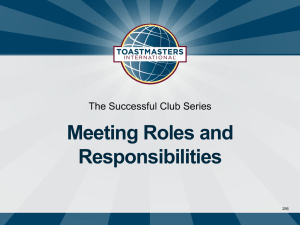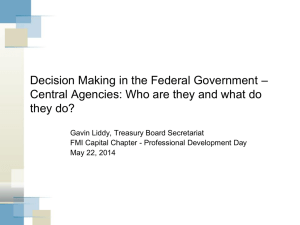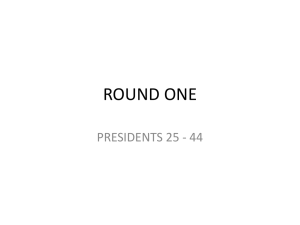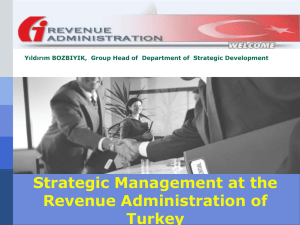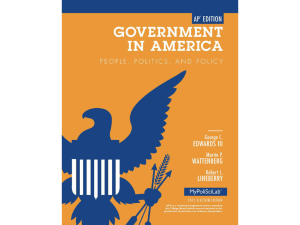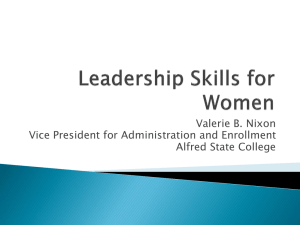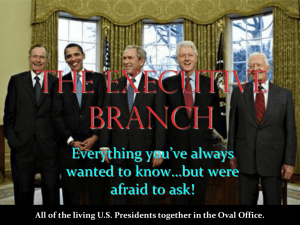The Presidency
advertisement
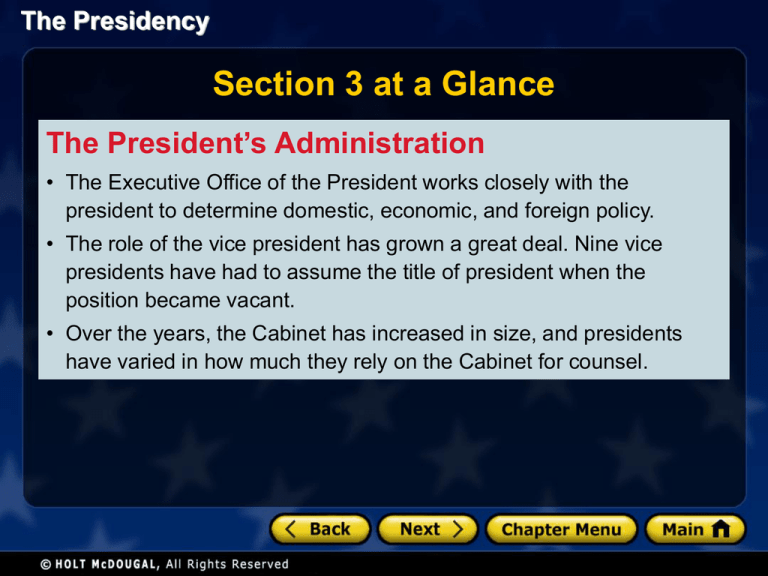
The Presidency Section 3 at a Glance The President’s Administration • The Executive Office of the President works closely with the president to determine domestic, economic, and foreign policy. • The role of the vice president has grown a great deal. Nine vice presidents have had to assume the title of president when the position became vacant. • Over the years, the Cabinet has increased in size, and presidents have varied in how much they rely on the Cabinet for counsel. The Presidency Executive Office of the President • President’s administration includes all working for executive branch • Most are career employees; at top are presidential appointees, who change when new president elected • Many belong to Executive Office of the President, including White House Office staff, National Security Council, Council of Economic Advisers Formation of EOP • R • Expansion of president’s staff began with Theodore Roosevelt • F • 1939: Executive Office of President authorized by Congress • M • EOP members often most influential people in administration The Presidency The White House Office Heart of EOP Duties of Chief of Staff • President’s key personal, political staff • Oversee president’s personal secretary, legal counsel • Most work in White House or Old Executive Office Building • Directs Congressional relations, Cabinet relation teams • President determines size of staff • Deals with presidential mail, appearances, other members of staff • Chief of Staff manages staff • Role varies president to president T • Manages speechwriters, press secretary, communications staff The Presidency The Presidency National Security Council • National Security Council coordinates security with top military, foreign affairs, intelligence officials • Created 1947 in reaction to Cold War rivalry with Soviet Union • Activities coordinated by national security adviser appointed by president Council of Economic Advisers • Created 1946, Council of Economic Advisers provides expert analysis of economy • Studies how trends, events may affect economic policy, how policy affects economy • Three members nominated by president, confirmed by Senate • Publishes annual Economic Report, study of economy after president submits budget The OMB • O • G • L The Presidency The Vice President The Vice Presidency • Only other elected official in president’s administration • Three major duties: presiding over Senate; opening, counting electoral votes; serving as president if president unable to serve—9 have done so Early Vice Presidency (cont’d.) • The few formal duties pleased some, troubled others • Jefferson: A more tranquil and unoffending station could not be found. • Garner: the spare tire on the automobile of government The Early Vice Presidency • 1800s: role did not amount to much • 2nd place in presidential voting became vice president • 1804: 12th Amendment required separate ballots • Candidate can help balance ticket The Modern Vice Presidency • Since 1970s, presidents rely more heavily on vice presidents to make policy, carry out programs • Have own staffs, more interaction • Vice president’s office close to Oval Office in West wing The Presidency The Presidency The Cabinet • O • Executive departments responsible for carrying out laws, administering programs, making regulations • M • As Cabinet, secretaries act as advisory body to president; nominated by president, confirmed by Senate The Presidency The Cabinet’s History The Cabinet Today • Duties outlined by Article II of Constitution • Nearly four times as large as first cabinet • Chief executive • 16 official cabinet positions, including vice president • Chief administrator • Commander-in-chief • Foreign policy leader • Chief agenda setter • Other high-ranking officials like chief of staff may be invited to join cabinet • Some presidents rely more heavily on Cabinet than others.
